The Children of Dan
(The Tuata de Danaan)
And the Greek Myths
In our attempt to understand the Europe-Israel connection it is well to consider the most obvious and first instance that reveals itself from both sides of the historical records, where we find Israel ascending up into Europe after the time of Moses under the collective name of Dan. Armstrong's World Wide Church of God has done as much as anyone to confuse the Universal Israel with the Anglo-Saxon nation-cults (imagining that they are the same), but it has also added much to our studies as well. The confusion that it and other American Zionist cults have created (which include certain Protestant churches along with the Mormon church, which together helped spawn the Klan and an Aryan mentality that presently exists throughout the nation), lies in the general inability to distinguish true holiness (and true righteousness) from what appears to be some certain relative, religious, and civic virtues of Anglo-American culture. These virtues, of course, have only been borrowed, or stolen, from the precepts of Christ themselves. It lies in everyone's general inability to distinguish the true Israel (the Israel of God that is in the process of being Born Again in our time), from the nations and empires that surround it and hold it captive. The difference is critical. Armstrong's work, nevertheless, helps us locate the mysteries of Israel in Europe when it associates the name Dan, or D-N, with the DANube, with MaceDONia, the DON river, DANtzig, with the Danes and ScanDANavia, and, perhaps foremost, with the legendary Tuatha De DANaans of Ireland.
Then all the children of Israel went out, and the congregation was gathered together AS ONE MAN, FROM DAN EVEN TO BE'ER-SHE'BA, with the land of Gilead, unto the Lord in Mizpeh...(Judges 20:1; 1 Samuel 3:20,21).
DANOS AND DANEL: A MYTHOLOGICAL COMPARISON
"An examination of the Greek myths of king Danaos, an eponym of the Danaans, and of his kin may help find a way toward a solution...In our approach we shall not begin by another attempt to reinterpret it as an historical relation. Historical hints, preserved in relics of the myth will be examined later. We should like to put the question this way: If the Argive Danaans really had come from the Semitic East...then this myth must have a close analogy to myths which are told in Syria, Phoenicia, and Palestine, about the hero whose name the Cilician Danunians bore. According to our previous conclusions, that ethnic name derives from Dan. And a hero of that name actually exists among the Western Semites. This was Daniel or Danel, hero of one of the W-S epic cycles discovered in the temple library of Ugarit. Judging from his having been mentioned twice by Ezekiel (14:14; 28:3), we can assume that he had been widely known, many centuries after the destruction of Ugarit.
Moreover, the hypothesis that the tribal name of the Danaans derives from the mythical hero Dan/Danel is corroborated by the existence of another W-S tribe with the same eponym--the Israelite tribe of Dan...both of whom are connected not only by their name but with 'judgment'--The archaic blessing of Jacob says, 'Dan will judge his people as one of the tribes of Israel.' (Genesis 49:16). And Danel, sitting in the threshing floor, judges the case of the widow and adjudicates the cause of the fatherless. (I Aqht:24-25; 2 Aqht V.7-8)--But the second saying of the blessing of Jacob on Dan (Gen.49:17) comparing him to a Serpent, is no less important in understanding his character. The Serpent always was, among the ancient Mediterranean peoples, the symbol of the chthonic underworld gods, the givers of fertility, harvest, and healing. And Danel is just such an agrarian-chthonic personage according to the Ugaritic epic. His main activity is in cornfields and vineyards...
In the Ugaritic poem Danel's and Pgt's hate of Ytpn stems from their desire for vengeance on behalf of their dead son and brother. In the Greek myths this motive is replaced by the Danaides' repugnance to the forced marriage to the Aigyptiads. This same motif is present in the Hebrew myth of Sechem (Genesis 34), which is remarkably close to the bloody wedding of the Danaides, and the heroine of which, moreover, bears the almost identical name Dinah (Dina), a feminine form of Dan. Dinah is raped by Sechem; he falls in love with her and, through his father Hamor, asks Jacob and his sons not only to give him Dinah for a wife, but to arrange a general intermarriage between the clans of Jacob and the Sechemites (as in the Argive myth, the collective marriage of the Fifty sons of Aigyptos with the Fifty daughters of Danaos...
We can see how the Hebrew Dinah
represents all Fifty daughters of Danaos. The letter D, or the Dalet in the
name of Dan, ![]() ,
is numerically equivalent in the ancient
Hebrew script to the number Four; and the number Four can also be expressed
as Four Dalets
,
is numerically equivalent in the ancient
Hebrew script to the number Four; and the number Four can also be expressed
as Four Dalets ![]() ,
which is the symbol of the great Universal Mandala of the Mystery of Christ
on the Tree of Life, which is also an expression of those mysteries that were
hidden by the Hebrew scribes in the center of Europe. And then the letter N,
or Nun, in the name DaN, is equal to Fifty, and 50 is the number assigned in
the Scriptures to the precepts of the Great Jubilee which must be observed by
all the children of Israel in the fulness of time. It must be observed in the
Seventh Month, which occurs during the Harvest Season in the Great Solar Year.
(Leviticus 25:8-13).
,
which is the symbol of the great Universal Mandala of the Mystery of Christ
on the Tree of Life, which is also an expression of those mysteries that were
hidden by the Hebrew scribes in the center of Europe. And then the letter N,
or Nun, in the name DaN, is equal to Fifty, and 50 is the number assigned in
the Scriptures to the precepts of the Great Jubilee which must be observed by
all the children of Israel in the fulness of time. It must be observed in the
Seventh Month, which occurs during the Harvest Season in the Great Solar Year.
(Leviticus 25:8-13).
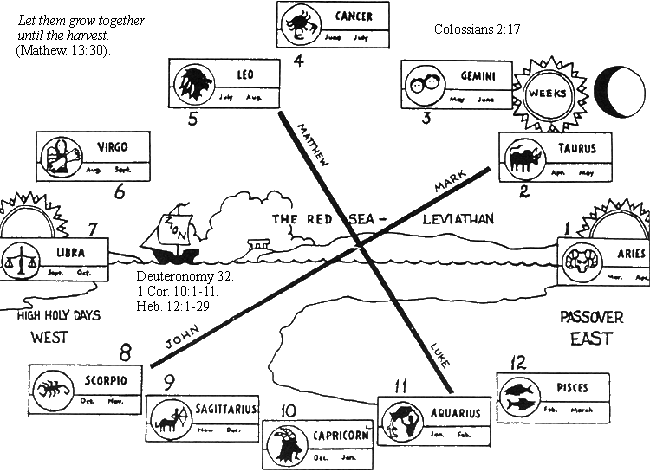
...The closest relationship between agriculture and justice--as in the figure of Danel--manifests itself in the Feast of Thesmorphoria, allegedly introduced by the Danaides and dedicated to the agricultural goddess Demeter (see Mark 4:26-29; John 12:23-25), the 'law carrier' or 'law-giver.' What is important is not the historical reliability of that version, but the very fact of the Danaides being associated with the main agrarian and chthonic feast of pre-Dorian women. Pgt, 'who knows the course of the stars,' is precisely the type of wise woman, expert in secret religious lore." (Please see Chapter V). HellenoSemitica, An Ethnic and Cultural Study in West Semitic Impact on Mycenean Greece, by Michael C. Astour.
At Genesis 9:18-27 we read: And the sons of Noah that went forth from the ark, were Shem, and Ham, and Japheth...These are the sons of Noah: and of them was the whole earth overspread. These, of course, were not the only people in the earth at that time, but they represented them scripturally. And then, not only all the peoples of the earth themselves but particularly those to whom the Hebrew teachings came. And Noah planted a Vineyard, whose branches would spread out over the whole earth, as it is also written: I am the True Vine. (John 15:1). This, of course, would prompt Paul to say: Drink a little wine for thy stomachs sake (1 Timothy 5:23), secretly indicating his knowledge of the whereabouts of that Vine (or perhaps we should say, those vines)...
THE IMPERIAL CITY
"It was Karl Marx who once used the image of the "old age that is pregnant with a new one," and called violence--the violence of revolution--the midwife at the birth. The birth of new Vienna was delayed, the midwife had not finished the job. Yet once the Emperor had decreed the disappearance of the old straitjacket, the fortifications round the town core, both demolition and construction followed quickly...
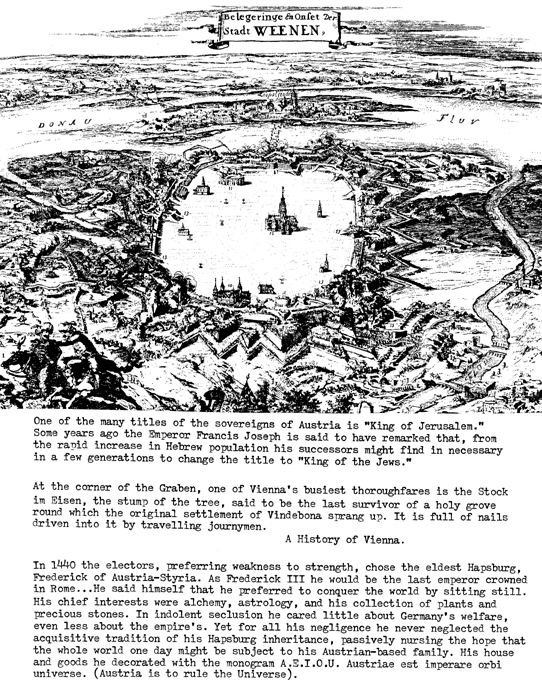
The Imperial letter-patent to Bach was dated 20 December 1857. The first step was to set up a commission which would have authority for everything connected with the expansion and rebuilding of the city, finance included. On 31 January 1858, projects were invited, a competition was thrown open to architects...The ramparts facing the Danube Canal (however) had already been razed, and a boulevard along the quay laid out...
The former Lutheran church in the castle of Hernals became the centre of religious stage-management at its theatrical best. After it had been reconsecrated in the presence of the court and emperor, THE CHAPTER OF ST. STEPHEN DECIDED TO BUILD NEXT TO IT A HOLY SEPULCHRE ON THE MODEL OF JERUSALEM.
A VIA CRUCIS (The Way of the Cross) WITH SEVEN STATIONS WAS MAPPED OUT, STARTING FROM THE DOOR OF ST. STEPHEN'S, PASSING THROUGH THE CITY GATE NEAR THE SCHOTTEN ABBEY, LEADING TO MOUNT CALVARY AND THE HOLY SEPULCHRE IN HERNALS. The city corporation payed for the first station, the others were built out of pious contributions. Every Friday before Palm Sunday, a penitentiary procession went from the cathedral to its goal in St. Bartholomew's Church, as it came to be called. Lay organizations called confraternities, a mediaeval tradition now refurbished by the Jesuits and giving the Viennese an outlet for their hierarchical ambitions, soon turned these processions into macabre carnivals...
The plain economic fact is that the vineyards in the lee of the Wienerwald were of the greatest importance to Vienna's everyday life, from the earliest beginnings. MODERN SCHOLARSHIP HAS ESTABLISHED THAT VINES WERE GROWN THERE EVEN BEFORE THE LEGIONARIES INTRODUCED THEIR MORE REFINED STOCK--up to the transformation of Older Vienna into Old Vienna...In 1524, a charter of Archduke Ferdinand called wine "the principal nourishment of the city of Vienna."...Customs of a strictly practical origin will be handed on as unquestioned rites and hallowed traditions, and largely survive the conditions whence they have sprung. Something of this kind happened with the vinous part of Viennese civilization. As long as the vineyards were cultivated around and between the Vorstadte--the last suburban vineyard was registered till the end of the eighteenth century--the interest of the Viennese in the quality of the New Wine, the Heurige, was matter-of-fact. It was no more than natural that the pleasantest, most popular wine-gardens were set up in the wine-growing villages outside the Line Wall, near the edge of the woods in the garden or yard of the vintner himself."
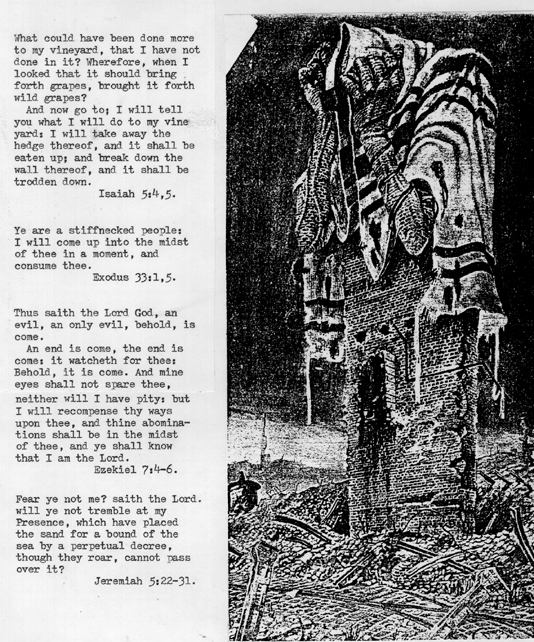

When ye therefore shall see the abomination of desolation, spoken of Daniel the prophet, STAND IN THE HOLY PLACE (WHOSO READETH LET HIM UNDERSTAND):
Then let them which be in Judaea flee into the mountains...(Matthew 24:15-22).
"Not far from Klosterneuburg...on a hill standing out from the Vienna Woods and in the city's XIXth district...Evacuation of this tomb in 1952 had found it constructed within a Roman building, with the present church standing over it. IT WAS EMPTY. Heiligenstadt was medieval Heylegenstatt (PLACE WHERE THE HOLY ONE HAS BEEN LAID) and has a twelfth century record of being known as LOCUS SANCTUS...The case must be reopened." Greeks, Celts, and Romans, p.130.
For, behold, the days come, and it shall be when the signs which I have foretold you come to pass, THEN SHALL THE CITY WHICH IS NOW INVISIBLE APPEAR, AND THE LAND WHICH IS NOW CONCEALED BE SEEN. And whosoever is delivered from the predicted evils shall see my wonders...(4 Ezra 7:26,27).
Not only do we learn what things were left hidden from the world by the adepts of the early Christian mysteries, but the whole of it also teaches us that as the ancient mysteries fell from the purely Hebrew into what will later be called the pagan state of mind, they seemed to take on a life of their own apart from their original source. The Mystery of Christ--and long before the time of Christ itself--was transformed into the mysteries of Dionysus, the god of the Vine. These are, of course, the very same that are expressed in the rituals and the liturgy of the Catholic Mass. And the Cup of Dionysus, or Bacchus, is the very same that is lifted to God at every Passover celebration. The wine in such rituals, however, is embued with Hebrew flavor and aroma, and consumed (we must assume) in a completely Hebrew frame of mind rather than pagan:
THE LORD OF THE VINE
1 Corinthians 11:23-29; John 15:1-13
"Dionysus began, probably as a type of sacred king (see Psalm 48:1,2) whom the goddess ritually killed with a thunderbolt in the Seventh month after the winter solstice, and whom her priestesses devoured. (see John 6:53-63). This explains his mothers: Dione, the Oak goddess; Io and Demeter, Corn goddesses (see Mark 4:26-29); and Persphone, Death goddess. Plutarch, when calling him 'Dionysus, a son of Lethe (Forgetfulness), refers to his later aspect as God of the Vine." (see Isaiah, chapter 5). The Greek Myths, by Robert Graves.
ZEUS AND DIONYSUS
"The supreme deity of the ancient Greeks, during their historical period at least, was Zeus. His name, referable to a root that means 'to shine,' may be rendered 'the Bright One.' (As Varuna in the Hindu myths...see Exodus 24:10). And since a whole series of related words in the various languages of the Indo-European are used to denote 'day' or 'sky,' it can be safely inferred that Zeus was called 'the Bright One' as being the god of the bright and day-light sky. Indeed, a presumption is raised that Zeus was first conceived, not in anthropomorphic fashion as the bright-sky god, but simply as the bright sky itself. (see 1 Thessalonians 5)...
Closely akin to the substantive Zeus is the adjective 'dios,' which denotes properly 'of' or 'belonging to Zeus.' This meaning it actually bears in Attic drama. But how is it that in the much earlier Homeric poems it has the force of 'bright,' or 'glorious' without any such restrictions to the property of a personal Zeus? Probably because the word was formed before Zeus became a personality, when as yet he was...'the Radiant Sky.' Dios in fact meant at first 'of' or 'belonging' to the Bright sky, and a vestige of its primary meaning is to be found in the frequent Homeric phrases, 'the bright upper air' and 'the bright dawn.'
The transition from brightness in this sense to glory and splendor in general is not hard to follow. Further, when Zeus came to be regarded as an individual sky god, the way was open for 'dios, of the bright sky' to take on the more personal meaning, 'of the god Zeus.'
Another adjective 'endios' occurs in epic verses with the meaning 'in broad daylight' or at 'Mid-Day.' For example, Nestor in the Iliad describes an expedition in which he had once taken part: 'At Mid-Day (endios) came to the sacred stream Alpheios.' Eidothea too in the Odyssey tells Menelaos the habits of her father Proteus: 'What time the Sun bestrides Mid-heaven, there comes shoreward the unerring Ancient of the Sea.' And fifty lines later: 'So, while Mid-Day (endios) endured and earth grew hot. More brilliant than crystal shone the sky.'" From a chapter entitled Zeus and the Sky.
"Elsewhere the same author expresses the Orphic belief that the infant Dionysus 'was a second Zeus...and sent the Rain Storm.' These and other indications of an essential connection between Dionysus and the rain warrant us in attaching weight to Pherekydes' statements. It would seem in Thraco-Phrygian myths, not only did Zeus descend upon Semele in rain when he (they) begat Dionysus, but Dionysus himself 'a second Zeus' came upon the 'nysai' or Trees, in the form of rain. (see Hosea 6:1-3 and Deuteronomy 32:1,2)...And after all 'nysai' (trees) are compatible with 'nysai' (nymphs), for nymphs may be tree-nymphs, and it is on record that Dionysus was nursed upon the Dryads, (nature spirits, or builders of perfect forms on the higher plane)...
Exception might be taken to Kretschmer's view that the sky-god was called Zeus by the Thracians as well as the Hellenes. That view is based on the fact that, just as Hellenic names derived from Zeus...so Thracian names begin sometimes with Deo-, Dio, Diu, sometimes with Deos-, Dios-, the twofold method of formation, producing on the one hand a compound, e.g. Dio-nysos, on the other a synthesis, e.g. Dios-nysos. But these data, it seems to me, are susceptible of another interpretation, viz. that corresponds with the Hellenic sky-god Zeus. There was a Thracian sky-god Dios, whose name coupled with an appelative appeared now as Dios Papas or the like, 'Dios the Father,' now as 'Dios-Nysos,' 'Dios the Son.' The Greeks familiar with Dios as the generative case of Zeus, would inevitably take this Dios-Nysos (or Dio-nysus) to mean Son of Zeus." From a chapter entitled Dios and Dios Nysos.
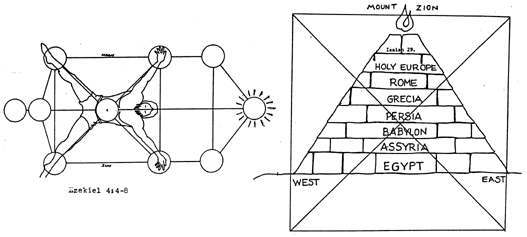
The Book Am-Tuat And The Book of Gates
"'Am-Tuat,'...i.e., 'The Book of what is in the Tuat,' is the name given by the Egyptians to the large funeral book in which the priests of Amen describe the Other World according to the views of their order, and the passage of their god Amen-Ra through the mysterious country which he traversed during the hours of the night...
The history of the Book Am-Tuat shows that the Egyptians treated it as they treated their older Books of the Dead; they first copied it on the walls of tombs, then on the sides of stone sarcophagi and wooden coffins, and next on rolls of papyrus. We have seen how the kings of the XVIIIth (during the time of Moses) and XIXth Dynasties had it copied on the walls of their tombs...
Similar in many details, but widely different from the Book Am-Tuat in point of fundamental doctrine (or so it seems), is the great funeral work to which the names 'Book of the Lower Hemisphere,' 'Book of Hades,' have been given. A glance at the pictures which accompany the texts of this Book is sufficient to show that it deals with the passage of the Sun-god through the Other World during the hours of Night, but as M. Maspero pointed out long ago, it is wrong to call the region through which the god passes by the name of 'Lower Hemisphere,' for it suggests (he seems to think) that it is below the surface of the earth, which is not the case. There is much to be said against the titles 'Book of Hades,' and 'Book of Hell,' and among the prominent characteristics that distinguish it from the Book Am-Tuat is a series of gates...It will be convenient and more correct to call it the 'Book of Gates...As the Book Am-Tuat was composed with the view of asserting the absolute supremacy of Amen-Ra in the Other World, so the Book of Gates was compiled to prove that, despite the pretensions of the priests of Amen-Ra, Osiris, the ancient god of the dead (and resurrection) was still the overlord of the Underworld, and that his kingdom was everlasting..."
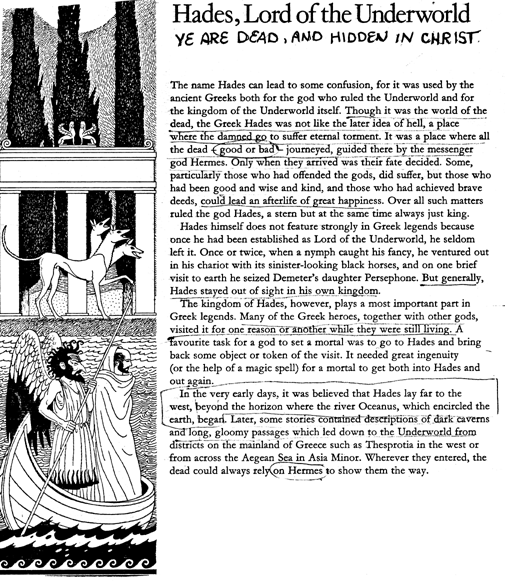
"This region was called by the Egyptians 'Tat,' or 'Tuat,' or 'Tuaut;' the oldest form of the name, and that which is met with in the earliest of the Pyramid Texts is 'Tat.' The chief god of the 'Tuat' was called 'Tuat'...and the beings who lived there were called 'Tuatiu.' The meaning of the name Tat, or Tuat, is unknown, and it is useless to speculate upon it or invent etymologies for it; it was applied to the home of the beatified spirits and the damned, no doubt in prehistoric times, and the exact meaning which it conveyed to the minds of those who first used it has been lost...
To find a word which shall at once describe the situation and character of the Tuat is impossible (says the author), for the reason that the Egyptian conception of the place of the departed spirits is unique (says the author)...On the whole, the word Tuat may be best rendered by 'The Other World,' or 'Underworld,' always provided that it be clearly understood that the Egyptians never believed it to be under the earth.
In inventing a situation for the Tuat, the Egyptians appear to have believed that the whole of the habitable world, that is to say, Egypt, was surrounded by a chain of mountains lofty and impassable...Outside of this chain of mountains...was the region of the Tuat; it ran parallel with the mountains, and was on the plane either of the land of Egypt or of the sky above it...The Tuat had the shape of a valley; and from the fact that it began near the place where the Sun set, and ended near the place where he arose, it is permissible to say that the Tuat was nearly circular in form. That this is the view taken by the Egyptians themselves is proved by the scene which produced in the Book of Gates. Here we have the body of Osiris bent round a circle, and the hieroglyphics enclosed within it declare that it is the Tuat." The Egyptian Heaven and Hell, by E.A. Wallis Budge, pp.80-89.
THE TUATHA DE DANANN
The Mythico-Historical Children of Israel
"The Irish race of today is popularly known as the Milesian Race, because the genuine Irish (Celtic) people were supposed to be descended from Milesius of Spain, whose sons, say the legendary accounts, invaded and possessed themselves of Ireland a thousand years before Christ.
But it is nearly as inaccurate to style the Irish people pure Milesian because the land was conquered and settled by the Milesians, as it would be to call them Anglo-Norman because it was conquered and settled by the twelfth century English.
The races that occupied the land when the so-called Milesians came, chiefly the Firbolg and the Tuatha De Danann, were certainly not exterminated by the conquering Milesians. Those two peoples formed the basis of the future population, which was dominated and guided, and had its characteristics molded, by the far less numerous but more powerful Milesian aristocracy and soldiery.
All three of these races, however, were different tribes of the great Celtic family, who, long ages before, had separated from the main stream, and in course of later centuries blended again into one tribe of Gaels--three derivatives of one stream, which after winding their several ways across Europe from the East...finally blended in amity, and flowed onward in one great Gaelic stream.
Of these three certain colonisations of Ireland, the Firbolg was the first. Legend says they came from Greece, where they had long been enslaved, and whence they escaped in the captured ships of their masters...But the possession of the country was wrested from the Firbolgs, and they were forced into partial serfdom by the Tuatha De Danann (people of the goddess Dana) who arrived later...
Totally unlike the uncultured Firbolgs, the Tuatha De Danann were a capable and cultured, highly civilized people, so skilled in the crafts, if not the arts, that the Firbolgs named them necromancers (practitioners of the art of revealing future events by calling up the spirits of the dead...compare 1 Samuel 28:7-15 and of the methods employed by the entire school of Christian prophets after the time of Christ..."For Christ was dead, and is now alive."); and in course of time both the Firbolgs and the...Milesians created a mythology around them. (continued)...
The question will arise, especially among present-day Jews: if the Tutha De Danann are among the children of Israel, why do we not find them in history speaking a Hebrew dialect? And the simple answer is, we do. The ancient Gaelic language is the proto-Hebrew dialect. The language that we associate with Hebrew in our time, which was not a spoken language at all in time of Moses (nor was it ever intended to be), was still being created over on the mainland of Europe. It was being devised by that school of the "Druid" religion that was versed in the emerging Hebrew literary tradition--in the allegories and stories--and in the Kabbalistic means by which the Indo-European-Gaelic language of that ancient time was being cryptically transmitted into a sacerdotal Hebrew script. The methods used presently fall under the headings of Gamatria, Notariqon, Temura, and Atbash. This Hebrew code was being devised for the use of the priests and Levites, so that they could keep the Hebrew mysteries (thus access to the oracles of truth) from the sons of Darkness (and it seems they succeeded)...
As these adepts in the Hebrew mysteries walked abroad, transmitting Hebrew precepts and teachings to the peoples around them, they had the ability, or the choice, to do so directly from their own hidden code, thus speaking directly to those who were candidates for initiation into the Inner mysteries, or outwardly in allegories and metaphors to the people at large. They read from their Hebrew code (which had no specific sound in itself other than the Gaelic from it was devised) but spoke to the people in the various languages and dialects of the peoples themselves. They might explain the mysteries of Christ for instance, which were written there in the types and images of their Torah code, in terms of what would later become the Druid cult of Hesus, or the Greek cults of Apollo and Dionysus, or the Thracian Adonis. All of which served in later times to create a mythological system among the other peoples and nations that seemed to be like the Hebrew myths, but different. The reality is that they are all directly related, and all the adepts in the World-mystery, throughout every succeeding generation, have found the freedom to interpret them as such and to interrelate them.
...Over on the island, which was now indisputably De Danann, reigned the hero Lugh, famous in mythology. And after Lugh, the still greater Dagda--whose three grandsons, succeeding him in the sovereignty, were still reigning, says the stories, when the Milesians came.
Such a great people were the De Danann, and so uncommonly skilled in the few arts of the time, that they dazzled even their conquerors and successors, the Milesians, into regarding them as mighty magicians, (Magi). Later generations of the Milesians, to whom were handed down the wonderful traditions of the wonderful people they had conquered, lifted them up into a mystic realm, their greatest ones becoming gods and goddesses (guiding principles and ideas) who supplied to their successors a beautiful mythology...
Lugh was not only the son of a god (of Manannan MacLir, the sea-god) and the greatest of heroes. (continued)...
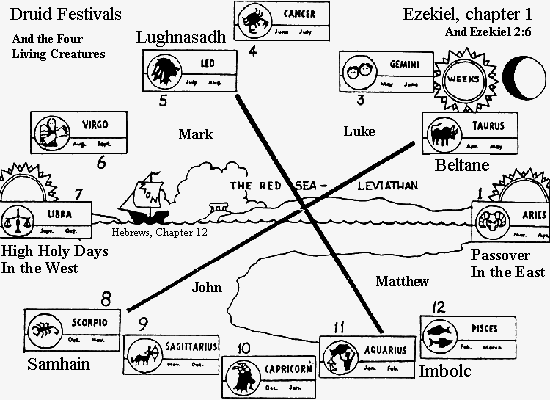
THE REALM OF THE TUATA
Beltaine, May 1; Lugnassad, Aug.1; Samhain, Nov.1; Imbolc, Feb.1...Ezekiel, chapter 1.
...but tradition gave him all the many mortal powers of his people, so that he was called Sab Ildanach meaning Stem of all the Arts. When the De Danann first arrived in Ireland Lugh went to the court of Eochaid, the Firbolg king at Tara (a later place-name derived from "Torah", from which the Law is issued forth), and sought an office. But no one was admitted a member of this court unless he was a master of some art or craft not already represented there. The doorkeeper barring Lugh's way demanded on what ground he sought to be admitted. Lugh answered that he was a "saer" (carpenter). No they had a good "saer" in the court already. Then he said he was a good smith. They had an able smith also. Well he was a champion. They already had a champion. Next, he was a harper. They had a wonderful harper too. Then a poet and antiquarian. They had such--and of the most eminent. But he was a magician. They had many Druids, adepts in the occult. He was a physician. They had a famous physician, Diancecht. He was a cupbearer. They had nine. Then a goldsmith. They had the famous Creidne. "Then," said Lugh, "go to your king, and ask him if he has in his court any man who is at once master of all these arts and professions. If he has, I shall not ask admittance to Tara."
Eochaid, the king, was overjoyed. He led in the wonderful Lugh, and put him in the chair of the "ard-ollam," the chief professor of the arts and sciences.
The Dagda, who reigned just before the coming of the Milesians, was the greatest of the De Danann. He was styled Lord of Knowledge and Sun of all the Sciences. His daughter, Brigit, was a woman of Wisdom, and goddess of poetry. The Dagda was a great and beneficent ruler for Eighty years." The Story of the Irish Race, A Popular History of Ireland, by Seumas MacManus, pp.1-6.
IRISH (Celto-European) GODS
The Celtic Hesus or Esus (Jesus) was a mysterious god of Gaul. The Irish form was "Aesar," meaning, "He who kindles a Fire," and the Creator. In this we are reminded of the Etruscan "Aesar," the Egyptian Sun bull "Asi," the Persian "Aser," the Scandanavian "Aesir," and the Hindoo "Aeswar." The Bhagavat-Gita says of the last that "he resides in very mortal."
Hesus was acknowledged in the British Isles. In one place he is represented with a hatchet, cutting down a Tree. As the Briton "Euzus," the figure is not attractive looking. Dom Martin styles Esus or Hesus "the Jehovah of the Gauls." He was perhaps the Aesar, or Living Ones of the Etruscans. Leflocq declares, "Esus is the true god of the Gauls, and stands for them the Supreme Being, absolute and free." The name occurs on an altar erected in the time of Emperor Tiberius, which was found in 1711 under the choir of Notre Dame, Paris.
Sun-gods were as common in Ireland as in other lands. (Understand Malachi, chapter 4)...The Irish sun-gods, naturally enough, fought successfully in summer (in the North), and the Bards give many illustrations of their weakness in winter. Sun heroes were not precisely deities, as they were able to go down to Hades. Aengus, the young sun, whose foster-father was Mider, King of the Fairies (the memories), was the protector of the Dawn goddess "Etain,"...His father was the great god Dagda.
Sun gods have usually golden hair, and are given to shooting off arrows (sunbeams), like Chaldean ones...They grow very rapidly, are helpers and friends of mankind, but are engaged everywhere in ceaseless conflicts with the gods or demons of darkness.
The Irish sun-gods had chariots, like those of the East. They indulged in the pleasures of the chase, and of fighting, but were more given to the pursuit of Erin's fairest daughters. Occasionally they made improper acquaintance with darker beings, and were led into trouble thereby.
"Grian" was the appellation of the sun, and "Carneach" for the priest of the Solar deity. Strabo mentions a temple in Cappadocia to Apollo "Grynaeus." Ovid notes a goddess called by the ancients Grane." The Phrygians had a god "Grynaeus." "Grane" and Baal both refer to the sun. J.T. O'Flarrety regarded the Irish word "Grian" as pure Phoenician. The "Four Masters" inform their readers that "the monarch Loagaire had sworn ratha-Greine agus Gavithe;" this is, by the Sun and the Wind. Breaking his oath, he was killed by these divinities. Eusubius held that Usous, King of Tyre, erected Two Pillars for worship to the Sun and the Wind.
The Phoenicians have been credited as the introducers of Irish solar deities. Sir S. Rush Meyrick held their origin in these islands from Arkite sun-worship: Tydain was the Arkite god, the Lord of Mystery. H. O'Brien, in "Phoenician Ireland", Dublin 1822, spoke of the Irish word "Sibbol" as "a name by which the Irish, as well as almost all other nations, designated and worshipped Cybele;" "sibola," an ear of corn, being a symbol of Ceres and Cybele of the Phoenicians...
The Gaulish "Belenus" was known over these Islands. In his temples at Bayeux and at Bath there were images of the Solar god. He was adored, too, at Mont St. Michel. A remnant of his worship is seen in the customs of maids washing their faces in May-morn dew, and then mounting a hill to see the sunrise. According to Schedius, the word may be rendered 2 + 8 + 30 + 5 + 50 + 70 + 200 or 365, the period in days of the sun's annual round. The solar Hercules was represented In Irish by "Ogmian" or "Ogham." The god of light was ever god of the Heavens...
"Samhan," literally servant, is derived from "Sam," the sun; (thus Samuel, the Druid priest of the Sun), so "samh-an," like the sun. As the Irish Pluto, he is guardian of the Dead. As such he would receive the prayers for souls on All Hallows Eve... Irish Druids and Old Irish Religions, by James Bonwick.
All of these ancient stories, myths and legends, along with the many various aspects of Nature worship that attended them (some based in the purely naturalistic and pantheistic framework of human thought, and others in the highly developed and intuitive frame of mind of the Hebrew prophets) are all directly related to, and for the greatest part flow from the Oral traditions of the Hebrew mysteries. Each of them were reconciled to the Hebrew Mysteries again in the time of Christ, in the Mystery of Christ...